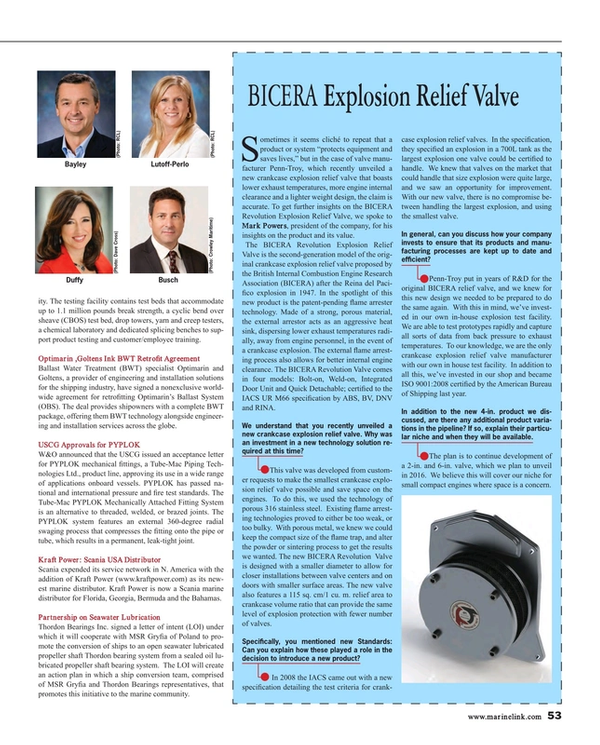
BICERA Explosion Relief Valve
Sometimes it seems cliché to repeat that a product or system “protects equipment and saves lives,” but in the case of valve manufacturer Penn-Troy, which recently unveiled a new crankcase explosion relief valve that boasts lower exhaust temperatures, more engine internal clearance and a lighter weight design, the claim is accurate. To get further insights on the BICERA Revolution Explosion Relief Valve, we spoke to Mark Powers, president of the company, for his insights on the product and its value.
The BICERA Revolution Explosion Relief Valve is the second-generation model of the original crankcase explosion relief valve proposed by the British Internal Combustion Engine Research Association (BICERA) after the Reina del Pacifico explosion in 1947. In the spotlight of this new product is the patent-pending flame arrester technology. Made of a strong, porous material, the external arrestor acts as an aggressive heat sink, dispersing lower exhaust temperatures radially, away from engine personnel, in the event of a crankcase explosion. The external flame arresting process also allows for better internal engine clearance. The BICERA Revolution Valve comes in four models: Bolt-on, Weld-on, Integrated Door Unit and Quick Detachable; certified to the IACS UR M66 specification by ABS, BV, DNV and RINA.
We understand that you recently unveiled a new crankcase explosion relief valve. Why was an investment in a new technology solution required at this time?
This valve was developed from customer requests to make the smallest crankcase explosion relief valve possible and save space on the engines. To do this, we used the technology of porous 316 stainless steel. Existing flame arresting technologies proved to either be too weak, or too bulky. With porous metal, we knew we could keep the compact size of the flame trap, and alter the powder or sintering process to get the results we wanted. The new BICERA Revolution Valve is designed with a smaller diameter to allow for closer installations between valve centers and on doors with smaller surface areas. The new valve also features a 115 sq. cm/1 cu. m. relief area to crankcase volume ratio that can provide the same level of explosion protection with fewer number of valves.
Specifically, you mentioned new Standards: Can you explain how these played a role in the decision to introduce a new product?
In 2008 the IACS came out with a new specification detailing the test criteria for crankcase explosion relief valves. In the specification, they specified an explosion in a 700L tank as the largest explosion one valve could be certified to handle. We knew that valves on the market that could handle that size explosion were quite large, and we saw an opportunity for improvement. With our new valve, there is no compromise between handling the largest explosion, and using the smallest valve.
In general, can you discuss how your company invests to ensure that its products and manufacturing processes are kept up to date and efficient?
Penn-Troy put in years of R&D for the original BICERA relief valve, and we knew for this new design we needed to be prepared to do the same again. With this in mind, we’ve invested in our own in-house explosion test facility. We are able to test prototypes rapidly and capture all sorts of data from back pressure to exhaust temperatures. To our knowledge, we are the only crankcase explosion relief valve manufacturer with our own in house test facility. In addition to all this, we’ve invested in our shop and became ISO 9001:2008 certified by the American Bureau of Shipping last year.
In addition to the new 4-in. product we discussed, are there any additional product variations in the pipeline? If so, explain their particular niche and when they will be available.
The plan is to continue development of a 2-in. and 6-in. valve, which we plan to unveil in 2016. We believe this will cover our niche for small compact engines where space is a concern.
(As published in the January 2015 edition of Maritime Reporter & Engineering News - http://magazines.marinelink.com/Magazines/MaritimeReporter)
Read BICERA Explosion Relief Valve in Pdf, Flash or Html5 edition of January 2015 Maritime Reporter
Other stories from January 2015 issue
Content
- Editorial: BWTS. Like it or Not, Here it Comes page: 6
- Marine Casualties & Fast Ferry Follies page: 8
- Bayonne Drydock Logs Successful '14 page: 10
- N-KOM Sees Increased Tanker Business page: 10
- Limitless Salvage page: 12
- What Keeps ‘Good Ship’ RINA Buoyant page: 20
- Dynamic Positioning & the Potential for USCG Regulations page: 24
- Chemical Tanker Turned OSV page: 26
- Shipbuilding, Repair and Conversion: Brazil's Quick Fix page: 30
- The Ballast Water Management Conundrum page: 34
- The Art of Propeller Making page: 44
- Lindner Sees Strong 2015 page: 48
- Beyond the Black Box page: 50
- BICERA Explosion Relief Valve page: 53
- Transas: The Bridge to Tomorrow page: 54
- Volvo Penta Debuts New Marine Engines page: 56
- VapCor Introduces Lindemann Marine Products page: 56
- New YANMAR EPA Tier III Engine page: 56
- New Gasket from Victaulic page: 56
- Clean Seal Molded Specialties Launched page: 56
- Dometic Debuts New Product Line page: 56
- First Container for LNG Hybrid Barge page: 56
- Wärtsilä to Power LNG-fueled RoPax Ferry page: 56
- Kidde Fire Systems: Multi-Language ARIES NETLink page: 56
- Next Generation Bridge Concept page: 57
- BCG Delivers Training Upgrades page: 58
- RescueME MOB1 page: 58
- New Stereo from ASA Electronics page: 58


